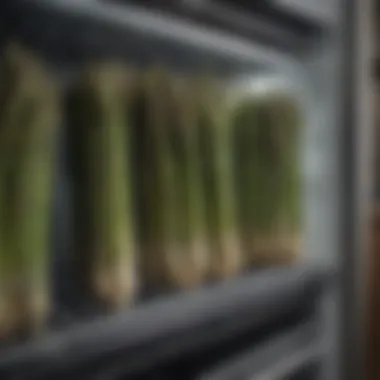Mastering Asparagus: An In-Depth Freshness Guide


Intro
Asparagus is a vegetable cherished for its delicate flavor and numerous health benefits. However, its shelf life can be quite short if not handled and stored correctly. This guide is tailored to help you explore various methods to preserve the freshness of asparagus. We will delve into storage techniques, ideal conditions, and practical tips for extending the life of this nutritious vegetable. Each section will highlight ways to maximize the quality and minimize waste, ensuring you can enjoy asparagus at its best.
One might wonder why understanding these methods is vital. Asparagus is often a staple in many kitchens, prized for its versatility in various dishes. Yet, without proper care, its vibrant taste and crisp texture can diminish quickly. This guide provides detailed insights for food lovers who value quality produce and wish to enhance their culinary experiences.
"Proper storage techniques can significantly extend the freshness of asparagus, leading to less waste and more vibrant dishes."
In the upcoming sections, we will break down specific storage methods, explore optimal environments, and offer tips to help keep this vegetable fresh longer. By implementing these practices, you can ensure a more sustainable approach to your cooking and reduce the frequency of food waste in your kitchen.
Intro to Asparagus Preservation
Asparagus is a vegetable that is both versatile and nutritious. Understanding how to preserve asparagus freshness is crucial for individuals who appreciate the quality and taste of their food. Proper preservation not only enhances the flavor of asparagus but also maintains its nutritional value. This article aims to provide useful techniques to extend the shelf life of asparagus while reducing kitchen waste.
Asparagus, when stored correctly, can retain its freshness for an extended period. Fresh asparagus is characterized by its vibrant green color, firmness, and a distinct, slightly sweet aroma. However, poor storage practices can lead to a rapid decline in these qualities. The goal of this section is to discuss the importance of proper preservation techniques, ensuring both flavor and nutritional benefits are safeguarded.
Nutritional Benefits of Asparagus
Asparagus is rich in vitamins and minerals. It contains vitamin K, vitamin A, folate, and vitamin C. This vegetable is also low in calories and high in fiber, making it an excellent addition to a balanced diet. The presence of antioxidants in asparagus, such as quercetin and gluthathione, can help combat oxidative stress and promote overall health. Regular consumption may support heart health and improve digestion, adding further to its appeal. Knowing the nutrition behind asparagus encourages more people to incorporate it into their meals.
Maintaining the freshness of asparagus is essential not just for taste but also for retaining its health benefits. Eating fresh asparagus is a delightful experience, both in terms of flavor and the nutrients it provides. Therefore, focusing on preservation techniques will help keep this vegetable at its best.
Understanding Freshness and Quality
Freshness and quality in asparagus are determined by various factors. These include the time elapsed since harvest, the storage conditions, and how the vegetable was handled before reaching the kitchen. Fresh asparagus should be straight and firm, without any signs of wilting.
When assessing the quality of asparagus, look for:
- Color: Bright green or purple tips are indicators of freshness.
- Texture: A fresh spear should be crisp and break easily when bent.
- Smell: A slightly sweet, grassy odor indicates high freshness.
It is vital to incorporate these elements into everyday practices to ensure that only the freshest asparagus makes its way into meals. Understanding these parameters enables both home cooks and culinary enthusiasts to select and maintain asparagus effectively.
Optimal Storage Techniques
Storage techniques play a crucial role in maintaining the freshness of asparagus. Proper storage extends the shelf life and preserves the taste of this nutritious green vegetable. One key element in this process is understanding the different methods available. Each method can yield varied results based on environmental factors and preparation circumstances. Here, we will delve into several effective storage strategies that have proven beneficial for asparagus preservation, helping to reduce waste and enhance your culinary experience.
Refrigeration Method
Refrigeration is perhaps the most straightforward method of storing fresh asparagus. This technique helps slow down the natural decay process. Within refrigeration, multiple sub-methods exist that cater to different situations and preferences.
Storing in Water
Storing asparagus in water is a highly effective method. The key characteristic of this technique is that it mimics the plant's natural growing conditions. By placing the spears upright in a container with water, they remain hydrated and firm.


The unique feature of this method is that it allows asparagus to continue absorbing water. This can prolong its freshness for up to a week. However, an important consideration is that the water must be changed every few days to avoid bacterial growth.
Using a Plastic Bag
Utilizing a plastic bag is another popular storage option. The key characteristic here is that it provides a conducive environment that reduces moisture loss. By sealing the asparagus inside a bag, you create a controlled environment, preventing air exposure.
A unique advantage of this method is that it is simple and requires minimal preparation. However, one drawback is that excessive moisture can accumulate in the bag, leading to spoilage. To counter this, it is helpful to include a paper towel inside the bag to absorb excess moisture.
Maintaining Humidity Levels
Maintaining proper humidity levels is essential in asparagus storage. The key aspect is that asparagus thrives in slightly humid environments. This is particularly relevant when using refrigeration methods.
Humid conditions reduce the rate of dehydration, which is essential for keeping asparagus crisp. A common practice is to use a damp cloth to wrap the asparagus before placing it in the refrigerator. While beneficial for maintaining moisture, it is crucial to monitor the conditions, as too much humidity can cause mold or spoilage.
Freezing Asparagus
Freezing is an excellent method for preserving asparagus for longer periods. It allows you to enjoy this vegetable well after its growing season. Prepping asparagus properly before freezing is critical for retaining its flavor and texture.
Prepping Asparagus for Freezing
When prepping asparagus for freezing, the focus is on blanching it first. This process involves briefly cooking the asparagus in boiling water, followed by an ice bath. The key benefit of blanching is that it halts enzymatic actions that can impact flavor and color.
Moreover, the unique aspect of this method is that it prepares the asparagus for storage without compromising its quality. However, it does require additional steps and time, which may deter some individuals from choosing this method.
Freezing Techniques
Various freezing techniques can be applied after prepping asparagus. The main characteristic is that freezing retains nutrients and prolongs shelf life. Individual freezing versus bulk freezing are common strategies.
A unique feature of individual freezing is that it allows easy access to portions. However, this process requires more space and time. Bulk freezing, while easier, can result in clumping, making it harder to take out desired amounts later.
Thawing Frozen Asparagus
Thawing is a crucial step in attaining the best quality of frozen asparagus. A popular approach involves transferring the asparagus from the freezer to the refrigerator overnight. This method ensures a gradual warming process, preserving texture.
The unique advantage is that this slow thawing method helps maintain the integrity of the asparagus. Nevertheless, it can be time-consuming. Quick methods, such as submerging in cold water, can be effective. Despite being faster, it may compromise both texture and flavor.
Alternative Storage Methods
For those who seek diverse techniques beyond refrigeration and freezing, alternative methods can be quite advantageous. Exploring different storage approaches can help maintain freshness while accommodating specific needs and available resources.
Storing in the Pantry
Storing asparagus in the pantry is not typical but can be effective under certain conditions. The key aspect is that asparagus should only be stored in a pantry if it is intended for immediate use.


The unique feature of this approach is its simplicity. It requires no special equipment or preparation. However, one significant disadvantage is that without refrigeration, the asparagus may only stay fresh for a very short time, generally a few days at most.
Using a Vacuum Sealer
Using a vacuum sealer is a modern solution that offers significant benefits. The key characteristic is that it removes air from packaging, which drastically slows spoilage.
A distinct feature of this method is durability; vacuum-sealed asparagus can last several months in the freezer without losing quality. However, the main drawback is the initial cost of purchasing a vacuum sealer and its accessories.
Drying Asparagus
Drying asparagus is another preservation technique that can enhance its usability. This method involves removing moisture to prevent microbial growth. The primary characteristic of dried asparagus is that it can be stored for much longer periods compared to fresh asparagus.
The unique advantage is that dried asparagus retains some nutrients and flavors, serving versatile purposes in cooking. However, cooking with dried asparagus may not replicate the texture and taste of fresh asparagus, which could be seen as a disadvantage.
Assessing Freshness Over Time
Evaluating the freshness of asparagus is crucial for maintaining its taste, nutritional value, and overall quality. Knowing how to assess freshness effectively allows cooks and food enthusiasts to optimize the lifespan of this vegetable. Proper assessment helps in deciding whether the asparagus should be consumed immediately, preserved for later use, or discarded. This knowledge is beneficial as it promotes sustainability in the kitchen by reducing wastage, enhancing meal quality, and ensuring better health outcomes.
Identifying Signs of Spoilage
Color Changes
Color changes in asparagus are often the first indicators of spoilage. Fresh asparagus is typically a vibrant green. However, as it ages, it may develop a yellow or brown tint. This change signals that the vegetable is losing its freshness and nutrients. Observing the color is easy and immediate, making it a practical choice for anyone handling asparagus.
The unique feature of color change is its visibility. By simply inspecting the asparagus, one can determine whether it is still suitable for consumption. However, it’s important to note that not all discoloration is indicative of spoilage, but it often correlates with a decline in texture and flavor.
Texture Alterations
Texture is another critical aspect of assessing the freshness of asparagus. Fresh asparagus should be firm and crisp to the touch. If it feels limp or squishy, it is an indication that the asparagus is beginning to spoil. This characteristic is beneficial as it can be easily gauged through touch, which is more subjective than visual assessments.
The advantage of evaluating texture lies in its direct relation to both culinary applications and health. Limp asparagus often signifies a loss of water content, which can affect cooking methods and results. Firm, fresh asparagus retains its structural integrity during cooking and provides a more enjoyable eating experience.
Odor Detection
The scent emitted by asparagus plays a significant role in identifying its state of freshness. Fresh asparagus has a mild, earthy aroma. However, as it spoils, it may develop a pungent or off-putting smell. This odor detection process is a beneficial attribute since it acts as a quick reference for determining edibility, without requiring intricate examinations.
The unique advantage of relying on odor detection is that it can often reveal spoilage even before visible or tactile signs appear. However, one must be wary since some individuals may have dulled senses of smell, making this method less reliable in certain situations.
Best Practices for Quality Control
Maintaining quality asparagus involves a series of best practices that goes beyond simple assessments. Key elements include:
- Regular Inspections: Check asparagus regularly for signs of spoilage as described above. This should be a routine aspect of your kitchen management.
- Proper Storage: Employ recommended storage techniques, be it refrigeration or freezing, to prolong the freshness.
- Timely Consumption: Prioritize using older asparagus first, to avoid waste.
- Educating Yourself: Learn about the life cycle of asparagus to better appreciate its freshness and best use.


Adopting these practices will help ensure that asparagus remains a delicious and nutritious component of your meals.
Integrating Asparagus in Culinary Practices
Integrating asparagus into culinary practices extends beyond simple cooking methods. It incorporates an understanding of flavors, nutrition, and preparation techniques that maximize the vegetable's potential. Asparagus offers unique taste profiles that can elevate various dishes. Its versatility complements a wide range of ingredients, adding both texture and flavor complexity.
Pairing Asparagus with Other Ingredients
Asparagus pairs well with a variety of ingredients. Some common companions include:
- Lemon: The acidity enhances the earthy flavor of asparagus.
- Parmesan Cheese: Rich and salty, it offers a delightful contrast.
- Olive Oil: Adds a smooth richness, perfect for drizzling before roasting.
- Garlic: Its pungency can bring another layer of depth to dishes.
Understanding these pairings adds versatility to your meals. By experimenting with flavors, one can discover combinations that appeal to individual tastes. This practice encourages creativity in the kitchen and promotes the use of fresh ingredients.
Cooking Methods and Prep Techniques
Grilling and Roasting
Grilling and roasting asparagus brings out a smoky flavor. This method contributes a slight char that enhances the vegetable's natural sweetness. The key characteristic is the caramelization that occurs at high temperatures, which adds complexity to simple dishes. Grilling requires only olive oil and seasoning for a delicious result, while roasting allows for larger quantities to be made simultaneously. The disadvantage can arise from overcooking, leading to a mushy texture.
Steaming and Sautéing
Steaming preserves the color and nutrients of asparagus. This method contributes to a crisp-tender bite that many find appealing. Sautéing, on the other hand, allows for the addition of various herbs and spices. Both techniques are beneficial choices as they require minimal time and maintain the vegetable’s vibrant appearance. The trade-off with steaming is a lack of added flavor, while sautéing can sometimes lead to a loss of nutrients if overdone.
Raw Consumption
Raw asparagus offers a unique texture and crunch. It is often used in salads or as a snack option. This manner of consumption retains maximum nutrients, making it a healthy choice. The key characteristic of raw consumption is the fresh and vibrant flavor that is delicate and crisp. However, not everyone favors this method due to the tougher texture, which some may find challenging to enjoy.
"Incorporating asparagus in various culinary practices not only enhances meals but also facilitates a deeper appreciation for its nutritional value and adaptability."
By integrating asparagus thoughtfully into dishes, home cooks can elevate their culinary skills while being mindful of preserving freshness. Employing various cooking methods and exploring ingredient pairings make for an enriching cooking experience.
Culmination and Takeaway Suggestions
The conclusion of this article encapsulates the vital approaches to preservng asparagus' freshness. Understanding the significance of effective storage techniques does not merely enhance the lifespan of asparagus; it also preserves its nutritional value and flavor, crucial to culinary applications. Proper storage means more than simply minimizing waste; it reflects a commitment to enjoying high-quality, delicious produce throughout its intended duration.
Summary of Key Points
In summarizing the key points discussed, we reviewed the following:
- Optimal storage techniques: The refrigeration, freezing, and alternative methods to retain asparagus freshness.
- Assessing freshness over time: Identifying spoilage signs through an awareness of color changes, texture alterations, and odor detection.
- Integrating asparagus in culinary practices: The importance of pairing it with the right ingredients and utilizing various cooking methods.
All these insights lead to a more informed way of handling asparagus, ensuring you make the most of your produce.
Encouraging Sustainable Practices
Sustainability in food practices is increasingly becoming essential. By implementing the techniques outlined, not only do we minimize waste but we also cultivate respect for the food we consume. Here are some suggestions for more sustainable asparagus handling:
- Purchase local asparagus when in season to reduce carbon footprints.
- Embrace imperfect produce; often these may not meet supermarket standards but are just as nutritious.
- Compost asparagus scraps; rather than discarding, consider how to turn waste into organic matter for plants.
By embodying these practices, we not only enhance our culinary experiences but also contribute to a healthier planet.







